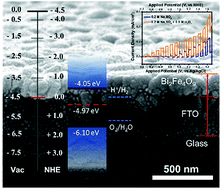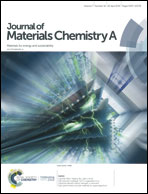Bi2Fe4O9 thin films as novel visible-light-active photoanodes for solar water splitting†
Abstract
We report the chemical solution deposition (CSD) of a phase-pure Bi2Fe4O9 thin film for use as a photoanode in photoelectrochemical (PEC) water splitting. The energy levels of Bi2Fe4O9 films have been measured and n-type characteristics have been confirmed. With band gaps determined as 2.05 eV (indirect) and 2.80 eV (direct) and valence and conduction bands straddling the water oxidation and reduction potentials, this material is highly promising as a photocatalyst for solar water splitting. The photocurrent of a planar photoanode reached 0.1 mA cm−2 at 1.23 VNHE under AM1.5G illumination. The addition of H2O2 as a hole scavenger increased the photocurrent to 0.25 mA cm−2, indicating hole injection is one limiting factor to the performance. The performance was enhanced by nearly 5-fold when the Bi2Fe4O9 photoanode is coupled to a Co–Pi surface co-catalyst. The photoanode also shows excellent stability with no change in photocurrent over three hours of continuous illumination. These results indicate that this material represents a promising addition to the growing selection of low-cost, stable photocatalysts for use in solar water splitting.



 Please wait while we load your content...
Please wait while we load your content...